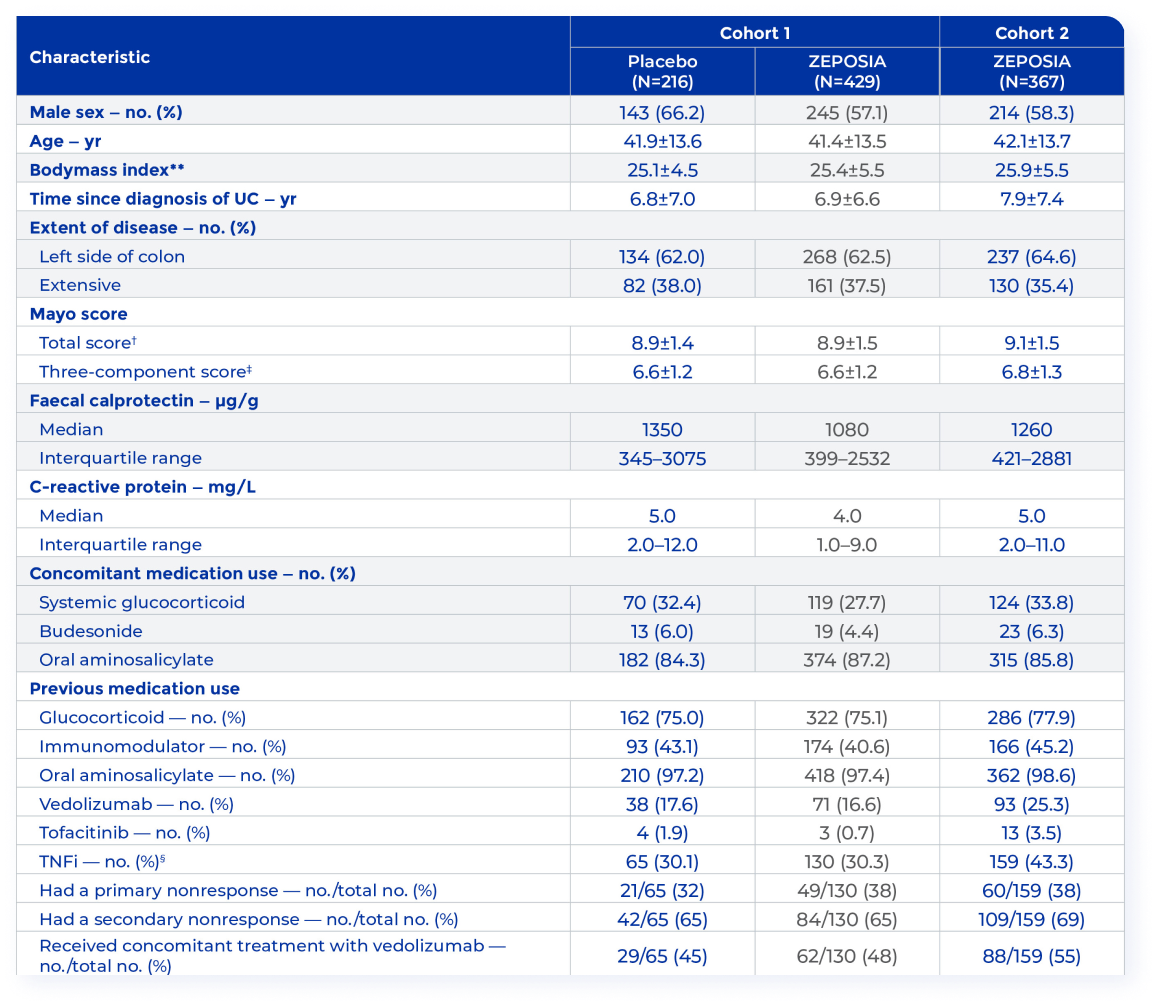This site is intended for Healthcare Professionals only. if you are a member of the general public, click here
ZEPOSIA was studied in the Phase 3 TRUE NORTH study1,2
The efficacy and safety of ZEPOSIA were evaluated in 2 multicentre, randomised, double-blind, placebo-controlled clinical study (UC study 1 [induction] and UC study 2 [maintenance]) in adult patients with moderately to severe active UC, defined as Mayo score of 6 to 12 at baseline.1

 Pinch & zoom to explore
Pinch & zoom to explore
Primary endpoint:
Clinical remission at week 10 (induction period) and at week 52 (maintenance period)†
Secondary endpoint:
Clinical response, endoscopic improvement, mucosal healing, histologic remission
Adapted from Sandborn WJ et al. 2021.
*Patients received concomitant aminosalicylates (e.g., mesalazine 71%; sulfasalazine 13%) and/or oral corticosteroids (33%) at a stable dose prior to and during the induction period.1
†Clinical remission was assessed using the three-component Mayo score and defined as a rectal-bleeding subscore of 0; a stool-frequency subscore of 1 or less, with a decrease of at least 1 point from baseline; and an endoscopy subscore of 1 or less (all on scales from 0 [none] to 3 [most severe]).
TNFi, tumour necrosis factor inhibitor; UC, ulcerative colitis.
TRUE NORTH baseline characteristics1

 Pinch & zoom to explore
Pinch & zoom to explore
*Plus–minus values are means ±SD. The modified intention-to-treat population included all the patients who underwent randomization and received at least one dose of ozanimod or placebo. In cohort 1, patients were randomly assigned to receive ozanimod or placebo; once the percentage of patients with previous exposure to a TNF antagonist reached 30%, subsequent patients with TNF antagonist exposure were assigned to cohort 2, in which they received open-label ZEPOSIA.
**The body-mass index is the weight in kilograms divided by the square of the height in meters.
†The total Mayo score is defined as the sum of the RBS, the SFS the physician’s global assessment subscore, and the endoscopy subscore. Overall scores range from 0 to 12 (with each subscore on a scale from 0 to 3), with higher scores indicating greater activity. Scores were assessed by a central reader.
‡The three-component Mayo score is defined as the sum of the RBS, the SFS, and the endoscopy subscore. Overall scores range from 0 to 9 (with each subscore on a scale from 0 to 3), with higher scores indicating greater activity. Scores were assessed by a central reader.
§Percentages in this category are based on the subgroup of patients who were treated with a TNFi. Data were from case-report forms. Patients may be classified under more than one response category if they had received more than one previous anti-TNF therapy and had a different response to each therapy. Primary nonresponse was defined as signs and symptoms of persistently active disease despite an adequate trial of induction treatment with an anti-TNF agent. Secondary nonresponse was defined as the recurrence of symptoms during maintenance therapy after a previous clinical benefit.
Adapted from Sandborn WJ et al. 2021.1
CS, corticosteroids; ITT, intention-to-treat; RBS, rectal bleeding subscore; SFS stool frequency subscore; TNF, tumour necrosis factor; TNFi, tumour necrosis
factor inhibitor; UC, ulcerative colitis.
References
- Sandborn WJ et al. NEJM 2021; 385(14):1280–1291.
- Zeposia (ozanimod) Summary of Product Characteristics, 2022.

